A heavily planted aquarium is a thing of great beauty and a joy to watch as the plants sway gently in the current while fish dart in and out of the foliage.
It’s also far more natural looking than cheap plastic plants and ornaments but how easy is it to start a planted aquarium?
The answer to that lies in how you approach the challenge.
It’s not just a matter of popping down to your local fish store, buying a few plants and planting them in your substrate.
This approach, which is common among beginners, will only lead to poorly growing and dying plants after just a few weeks of them being in the aquarium. When this happens people naturally get frustrated and often just give up on live plants.
To successfully start a planted aquarium you need to take a step back and understand fully what the requirements are.
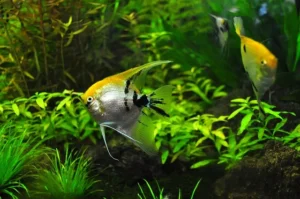
Table of Contents
Benefits of A Planted Aquarium
Before we look at what you need for a planted aquarium let’s have a look at the benefits of a planted aquarium.
As well as being beautiful to look at, a planted aquarium has many other benefits for both the tank itself and its inhabitants.
Plants provide natural cover and hiding places for your fish which will make them feel more secure and less stressed. As distressed fish are more prone to diseases, like Ich, keeping them stress-free is very important.
If you are familiar with the nitrogen cycle and are aware of the need to cycle your tank before adding fish, then you will know that the end product of the nitrogen cycle is nitrates.
Plants consume nitrates and other excess nutrients as food so they will help to keep nitrate and other harmful levels down.
Excess nutrients in your tank will almost certainly lead to algae problems so having live plants in your tank means that they can outcompete the algae and keep it to a minimum.
Furthermore, as part of photosynthesis, plants produce oxygen which helps oxygenate the water.
What You Need For a Planted Aquarium
Let’s now have a look at what you need for a planted aquarium to thrive.
Water Chemistry For a Planted Aquarium
Aquarium plants do best in soft to moderately soft water with a PH (acidity) between 6.4 and 7.4. They also have specific requirements for general hardness (GH) and carbonate hardness (KH).
General hardness is a measure of the total amount of dissolved salts in the tank and is a source of potassium, magnesium, calcium, and other trace elements used by plants (and fish).
Ideally, GH should be kept between 4 – 6 dGH.
KH measures the dissolved carbonate and bicarbonate salts in the water.
Plants consume CO2 during the day and release it again during the night which has an impact on the PH of the water.
Lowering CO2 raises the PH and increasing CO2 lowers the PH and large swings in PH are detrimental to both plants and fish.
Carbonate acts as an important buffer to stabilise PH. When CO2 increases and the water becomes more acidic (i.e. a lower PH), carbonate binds the excess acid to form bicarbonate which raises the PH.
Conversely, when CO2 decreases, carbonate releases CO2 creating carbonic acid that then lowers the pH.
It is somewhat complicated. You just need to know you should try and maintain a KH level of 2 – 4 dKH.
You will need to test the PH, GH and KH of your water on a regular basis using a good freshwater test kit if you want to successfully keep plants in your aquarium.
The best way to maintain stable water parameters is by using RODI water with trace minerals and PH buffers added to it.
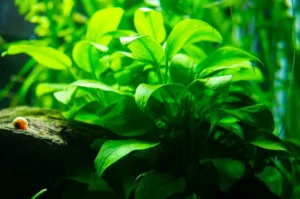
Substrate For a Planted Aquarium
Choosing the right substrate for a planted aquarium is one of the most important steps to take if you are going to be successful.
If the substrate is too fine it will compact over time preventing the roots of plants from penetrating. If it is too coarse and loose roots will not find sufficient grip to take firm hold.
The ideal grain size for a planted aquarium is about 2 to 5 mm.
Plants also need nutrients if they are to survive and thrive and whilst these can be added in the form of fertilisers, many plants draw their nutrients from the substrate rather than the water column.
As such a number of so-called ‘active’ substrates were developed such as ADA Aqua Soil which is full of plant-specific nutrients. However, these are easily stirred up, can alter PH, break down over time, and need to be replaced every 2 -3 years as the nutrients are exhausted.
Inert substrates, such as your typical aquarium sands and gravel do not break down and will last forever but they lack the basic nutrients your plants need.
However, this can be remedied by using fertilising root tabs which are buried in the substrate close to the plant roots.
Perhaps the best solution, though, is to use a substrate that is both inert and also contains, or is able to retain, the nutrients plants need.
Flourite is such a substrate. Made from fractured porous clay gravel, flourite has a porous structure and non-compacting way of settling which allows nutrient collection and free water flow.
Flourite will not alter the pH of the water, is not chemically coated or treated and will last for the life of your aquarium and not need replacing.
We recommend the one below:-
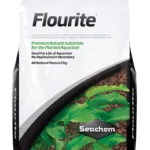 | Seachem Flourite Aquarium Substrate | Check pricing on eBay >> *Free UK Delivery |
If you do chose flourite for your planted aquarium, be sure to rinse it thoroughly before adding it to your tank.
Lighting For a Planted Aquarium
Having the correct lighting for a planted aquarium is another key factor to take into account.
Like all plants, aquatic plants require light to photosynthesise and to maximise that they require lights of the correct intensity and spectrum.
Kelvin represents the “color” (which is based on the temperature) of the light.
The spectral output should be between 6500 and 8000 Kelvin for a planted aquarium with intensity depending on plant species and water depth.
Plants absorb light for photosynthesis primarily in the red and blue areas of the spectrum and lights with low intensity in these wavelengths will fail to grow good plants despite how bright they may seem.
Aquatic plants can be broadly divided into 3 groups depending on their light requirements. Examples:-
- Low – Anubias, Java fern, Java moss, Crypts and Amazon sword
- Medium – Rotala, Vallisneria, Red Ludwigia and Moneywort
- High – High-powered lighting will grow any plants but may require additional CO2 Injection.
Modern LED lighting is the way to go with the best lights having a combination of bright 6500 K white LED’s with tri-coloured RGB LED’s so you can adjust the spectrum to your needs.
You should also be able to set a 24-hour light cycle with a ramping up/down option to mimic sunrise and sunset. We recommend the ones below:-
For plants with low to medium light requirements:-
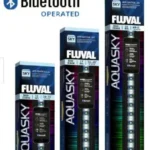 | Fluval AquaSky LED Lighting 7 sizes Tanks from 38 – 145cm in length | Check pricing on eBay >> *Free UK Delivery |
For plants with high light requirements:-
 | Fluval Plant 3.0 4 sizes Tanks from 38 – 153cm in length | Check pricing on eBay >> *Free UK Delivery |
Both the Fluval Aquasky and Fluval Plant 3.0 have all the power and features you need controllable from an App on your smartphone.
We recommend keeping the lights on somewhere between 9 – 12 hours a day (including ramp up/down time).
Heating For a Planted Aquarium
Aquatic plants have similar heating requirements to tropical fish so you will need a good heater.
Temperature stability is perhaps more important, so we recommend always using a temperature controller on your aquarium.
Fertiliser For a Planted Aquarium
In a lightly planted tank with only a few slow-growing plants, the plants will get all the nutrients they need from fish and food waste so the need for adding additional fertilisation will be minimal.
However, depending on the number and type of plants you add, at some point, you will need to give them a boost by adding a fertiliser.
Some plants draw up nutrients via their roots, others from the water column through their leaves but most aquarium plants do both.
There are two main types of fertiliser for a planted aquarium.
Substrate Fertilisers – Usually in the form of tabs or tablets which are placed directly in the substrate close to the plant’s roots. Plants draw the nutrients over time as the tablets dissolve.
They should last around 2 – 3 months and you should then add more.
Liquid Fertilisers – Are added to the water column on a regular basis and are perhaps the easiest to use. There are many different types available but we recommend the one below:-
 | Seachem Flourish | Check pricing on eBay >> *Free UK Delivery |
You are likely to require both types of fertiliser but take care not to overdose fertilisers as this may lead to excess algae growth.
Co2 For a Planted Aquarium
Plants use CO2 during photosynthesis, extracting the carbon they need and releasing oxygen.
A heavily planted tank with good lighting will quickly exhaust the available CO2 so to get the best growth in your plants you will need to add more.
There are two main ways to do this.
CO2 Reactor/Diffuser – These are for more advanced aquarium keepers and we cover their use in more detail in this article, Using Co2 For A Planted Aquarium.
Basically, a pressurised CO2 canister or tank with a suitable regulator is connected via tubing to a diffuser that releases tiny bubbles of CO2 into the aquarium.
As the bubbles rise in the tank water, they dissipate and release the CO2 for the plants to consume.
Liquid Carbon Supplements – Using a liquid carbon supplement is nowhere near as effective as CO2 gas injection but it can certainly help your plants to grow and is a good place to start for the beginner.
They also help to reduce algae, indeed many are sold as such. There are many different liquid carbon supplements available but we recommend the one below:-
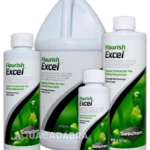 | Seachem Flourish Excel | Check pricing on eBay >> *Free UK Delivery |
Adding Plants To Your Aquarium
Creating a beautiful aquascape using live plants has developed into something of an art form. Indeed there are even competitions to find the best ones!
However, for beginners, if you follow a simple guideline of where to place your plants you won’t go far wrong.
Put simply, taller plants should be placed at the back of the tank with smaller plants towards the front.
Background Plants – These are larger plants placed at the back so as not to obstruct the view. Species include: Water sprite, Brazilian pennywort, Amazon sword, Vallisneria, Bacopa caroliniana and Pearl weed.
Middle Ground Plants – These are slightly larger than foreground plants and are usually thicker adding a fullness and depth to the aquarium. Species include: Anubias, Ferns, Cryptocorynes, Alternanthera reineckii and Dwarf Cardinals.
Foreground Plants – Stay relatively short so as not to obscure your view of the middle and background plants. Species include: Grass-Like Plants, Epiphyte Plants, Carpeting Plants, Anubias Nana Petite, Bucephalandra, Java moss or other moss, Cryptocoryne parva.
If you are just getting started on your planted aquarium, see our guide on the Best Live Aquarium Plants For Beginners.
Find Great Live Aqaurium Plants on eBay
Choosing Fish For a Planted Aquarium
Most tropical fish will do well in a planted aquarium but there are definitely some that you should avoid. These fish will either eat or tear up your plants.
The ones to steer clear of include cichlids, silver dollars, larger catfish and some loaches.
What you should choose are smaller peaceful fish that won’t eat or disturb your plants.
Take care when researching the fish you intend to add and make sure they are compatible with a planted aquarium.
Schooling fish like small tetras, rasboras or gouramis look great in a planted aquarium.
All the fish listed in our Best Freshwater Community Tank Fish guide are suitable for a planted aquarium so be sure to check that out.
Start A Planted Aquarium FAQs
Are planted aquariums hard to maintain? – No. In fact, they can be easier to maintain once they have become established. Plants consume nitrates and phosphates as they grow meaning you can reduce water changes.
They will also out-compete algae meaning less cleaning of the glass and any rocks or ornaments.
Are planted tanks good for beginners? – There is no reason why a beginner aquarist can not start out using live plants. Just make sure you pick easy-to-grow plants that do not have any special requirements.
Our guide, Best Live Aquarium Plants For Beginners will give you some pointers.
Do I really need CO2 in my planted tank? – Not necessarily. Easy-to-grow plants will be fine taking the energy they need from your tank lights and nutrients in the water.
However, a heavily planted tank with good lighting will soon exhaust the available CO2 and more will need to be added. For more information read our article, Using Co2 For A Planted Aquarium.
Do planted tanks need water changes? – Yes they do but you should be able to reduce the frequency of water changes. Plants consume excess nitrates, phosphates, and other nutrients cutting down the amounts available to algae.
